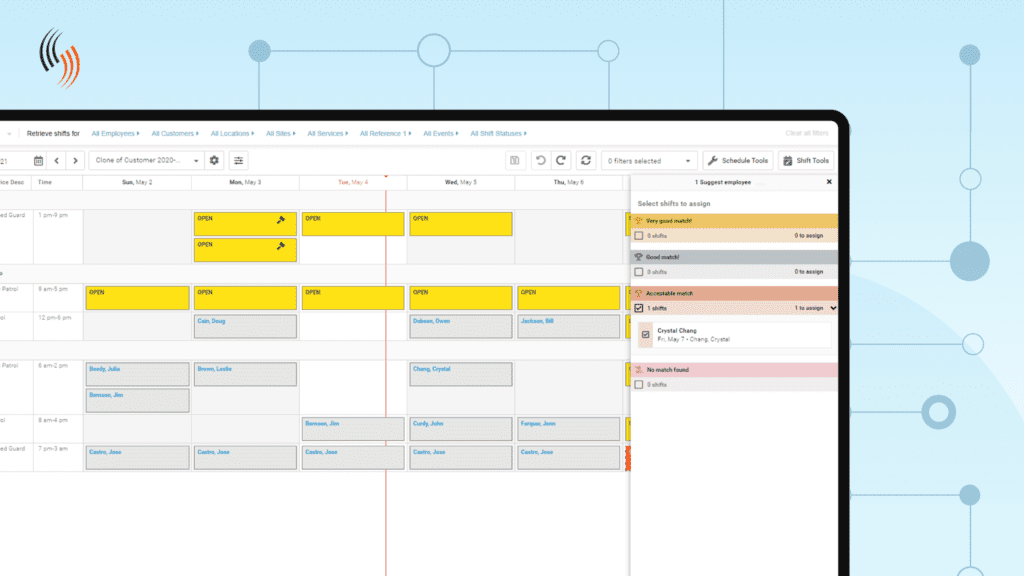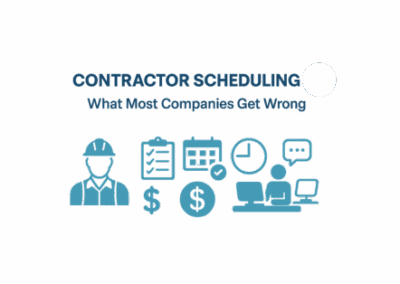This eBook is also available to download.
What is Artificial Intelligence?
Artificial intelligence, or more commonly abbreviated to “AI”, is a common buzzword that is thrown around the business community. What exactly is AI? AI can be defined as “a system’s ability to correctly interpret external data, to learn from such data, and to use those learnings to achieve specific goals and tasks through flexible adaptation.” The term is frequently applied to the project of developing systems with human characteristics, such as the ability to reason, discover meaning, generalize, or learn from past experience. Below, we will examine just how businesses can use artificial intelligence in scheduling.
A Brief History or AI
In 1956, John McCarthy, a computer scientist widely considered to be the grandfather of artificial intelligence, coined the term, “Artificial Intelligence”, defined as “the science and engineering of making intelligent machines”. McCarthy also created one of the very first computer “networks” and envisioned today’s “cloud” computing environment. AI isn’t a single technology: it is a collection of technologies and areas of research involving human decision-making.
Is AI Equal?
Currently, AI is classified into four different types of machines: reactive, limited memory, mind, and self-aware. Reactive machines do not form memories and do not use the past to base their decision upon. A famous reactive machine is the IBM Deep Blue machine that beat a chess grandmaster. Most of the AI we know today falls under this category. Limited memory machines can look in the past to determine the next best move but cannot form memories. One great example of this is self-driving cars. They use their cameras to observe the cars around them to know if it is safe to switch lanes or turn onto a new road.

Mind machines (for the moment an idea only) however, know that objects around them are sentient and can form feelings and thoughts that can influence their own behaviour. The final type of AI is self-aware machines, which like mind machines are entirely an idea at the moment. These machines have a consciousness and are therefore able to think for themselves.
Will Artificial Intelligence Take Over The World?
The short answer? No.
Not with what we know today. Computers do very well in repetitive task behaviours, and we can make them simulate intelligence, but at best, they are best at looking for patterns in very large amounts of data very fast, and make very good guesses at the meaning of the data as long as we tell it how or what to look for.
Artificial Intelligence in Employee Scheduling
How useful is AI to your Business?
One of the most valuable uses for AI in business is in looking at very large amounts of information that a human is incapable of. For example, Celayix uses your entire schedule history in seconds to recommend improvements. You can create a schedule that will work, but how do you know it is the best schedule?
When you’re a small company, scheduling can seem easy. If there is an open shift, find an employee to work the shift. Many smaller companies schedule by hand, and that is a viable solution in the short term. If you have 10-25 employees and one location, scheduling on the back of a napkin or Microsoft Excel is pretty easy.
Now consider those 10-25 employees and:
- Add a new location
- Consider their regular or overtime hours
- Check their certifications
- Review their experience
- Check their preferred working days
- Two of them call in sick
- Add new government regulations
- Add a new client contract with client requirements and preferences
- Throw in a pandemic with new health and safety requirements
- Double the size of your organization
Now…figure out whether it’s the best quality schedule you can make? See the problem now? How do you grow without your schedule process collapsing?
Rules Based Scheduling vs. AI
Most scheduling companies use a rules-based engine to power their software and schedule employees. There are a few problems with having predefined rules for each customer. If the scheduling company only has a limited number of rules or can only do specific features, you can’t always make them fit your particular needs. There can also be specific processes that may be too complex and too difficult for some rules based engines. Finally, every customer can have different rules and needs, which causes many hours of labor on both the company and the scheduling company’s employees to figure out all the rules needed to schedule efficiently.
This is where AI can help. AI pushes scheduling to the next level and can discover new rules from historical data. Instead of you trying to find patterns manually, AI can use machine learning and deep neural networks from the historical scheduling data of the client to discover rules. This greatly reduces the manpower needed to find rules and customize pre-defined rules for each client.
The use of Celayix AI helps generate better schedules faster that simply wouldn’t be practical or cost-effective by humans. Celayix AI doesn’t replace humans – it makes them better decision-makers.
Another use of AI Celayix is exploring is labor forecasting: having the ability to recommend improvements to labor demand and scheduling can help with cost reduction goals. With the use of AI, scheduling companies can create configuration-free tools to solve shift generation and shift assignment problems – with less effort. AI can predict the needs for specific industries and resolve major problems in seconds. The more the Celayix AI is used, the more data there will be for Celayix AI to learn about scheduling and our AI will be able to give better advice on how to get from good, to great.
How Great is Celayix AI?
Well, it’s not rigged up with duct-tape or convenient marketing lingo. Celayix builds its AI tech on top of two AI software development platforms: Amazon Sagemaker and Google Tensorflow.
The machine learning models that Celayix create are developed using Google Tensorflow, an open-source machine learning/AI software library. Other companies using Google Tensorflow include AirBNB, Uber, and Dropbox, and of course, Google. Amazon Sagemaker is an AI/machine learning managed services platform on Amazon Web Services (AWS). Our products are already hosted on Amazon, and
since they support the deployment of Google Tensorflow on Sagemaker, it made sense for us to use it for our AI technology. Companies using Sagemaker include Apple, NASCAR, and General Electric.
Celayix takes its experience and innovations around scheduling and designs its AI solutions on top of two of the world’s leading technology platforms to ensure we have a long-term stable and high-performance platform for our AI investments.
How Does Celayix use AI today?
At the moment, Celayix has two tools that use AI. The first tool is to recommend best-fit employees. When Celayix AI suggests employees into a shift, it will not only show only those employees that are qualified for the shift, but also give them ratings and rank them for best-fit. The second feature in this tool, the Verify Schedule feature, will recommend improvements to shifts that are already assigned. In addition to this tool, Celayix uses AI to add value-based recommendations in existing features, such as autofill and shift-bidding.

Further, Celayix uses AI and its rules engine for its Find Replacement feature to provide a superior alternative to typical shift-swapping solutions. For most organizations, shift-swapping involves Employee A trading shifts with Employee B. Even with supervisor approval, there is usually no way to ensure that scheduling Employee B in that shift is the best value for the organization. This process also places the burden on the Employee A to find their replacement. Rather than duplicate a bad manual process, Celayix enables Employee A to simply drop the shift, and Celayix provides the supervisor with a fully compliant and best-fit replacement in seconds – one that is in the best interests of the organization.
How is Celayix Different?
Celayix’ advantages come from having over 20 years of experience in the scheduling market. AI machine learning is only as good as the size and quality of data used for the models. Having such a large high-quality data set will help Celayix AI become more precise and accurate every day. Newer competitors may not have a sizable data set to base an effective AI model around, and would invariably provide lower-value improvements.
What’s next for AI at Celayix?
As a company, we are always looking at ways to improve our product. Perhaps by the time you read this, we will have solved a number of new problems we are working on now to make schedules fairer to all employees while ensuring the organization’s best interests are also met. We want to spread the Celayix AI to other parts of the scheduling system to both cut the time you spend managing schedules
AND create better schedules automatically.
If you have any questions about this article or artificial intelligence based scheduling, please reach out to us here and we’ll be happy to answer those questions! Or, if you want to see it in action, request a free, live demo here!



